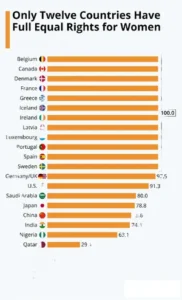International Women’s Day is celebrated globally on 8th March. This is an annual celebration. This year in 2023, also we are going to celebrate the International Women’s Day under the theme “DigitALL: Innovation and technology for gender equality.”

International Women’s Day
International Women’s Day is dedicated to celebrate the social, economic, cultural, and political achievements of women, as well as raising awareness of the ongoing struggle for gender equality.
The day also marks a call to action for accelerating gender parity. Significant activity is witnessed worldwide as groups come together to celebrate women’s achievements or rally for women’s equality.
HISTORY
International Women’s Day ( IWD ) started with the labour movement to become a recognised annual event by the United Nations (UN).
In 1908, 15,000 women marched through New York City demanding shorter working hours, better pay and the right to vote. A year later, the Socialist Party of America declared the first National Woman’s Day.
The idea to make the day international came from a woman called Clara Zetkin, communist activist and advocate for women’s rights. She suggested the idea in 1910 at an International Conference of Working Women in Copenhagen.
There were 100 women there, from 17 countries, and they agreed on her suggestion unanimously. It was first celebrated in 1911, in Austria, Denmark, Germany and Switzerland. The centenary was celebrated in 2011, so this year we’re celebrating the 111th International Women’s Day. Things were made official in 1975 when the United Nations started celebrating the day. The first theme adopted by the UN (in 1996) was “Celebrating the Past, Planning for the Future”.
8th March
Clara’s idea for an International Women’s Day had no fixed date. It wasn’t formalised until a war-time strike in 1917 when Russian women demanded “bread and peace” – and four days into the strike the Tsar was forced to abdicate and the provisional government granted women the right to vote. The date when the women’s strike commenced on the Julian calendar, which was then in use in Russia, was Sunday 23 February. This day in the Gregorian calendar was 8 March – and that’s when it’s celebrated today.
Celebrations
International Women’s Day is a national holiday in many countries, including Russia where flower sales double during the three or four days around 8 March. In China, many women are given a half-day off work on 8 March, as advised by the State Council. In Italy, International Women’s Day, or la Festa della Donna, is celebrated by the giving of mimosa blossoms. The origin of this tradition is unclear but it is believed to have started in Rome after World War Two. In the US, the month of March is Women’s History Month. A presidential proclamation issued every year honours the achievements of American women.
UN Themes
2018 – “Time is Now: Rural and urban activists transforming women’s lives”.
2019 – ‘Think equal, build smart, innovate for change’. The focus of the theme was on innovative ways in which to advance gender equality and the empowerment of women, particularly in the areas of social protection systems, access to public services and sustainable infrastructure.
The federal state of Berlin marked International Women’s Day as a public holiday for the first time.
2020 – ‘I am Generation Equality’: Realizing Women’s Rights’. Despite the COVID-19 pandemic, street marches occurred in London, Paris, Madrid, Brussels, Moscow and other European cities. The Aurat March in Islamabad was marred by attacks from stone throwers, after a failed attempt to have it banned as un-Islamic. In Bishkek, the capital of Kyrgyzstan, police detained dozens of marchers shortly after masked men reportedly attacked the march.
2021 – “Women in leadership: Achieving an equal future in a COVID-19 world”, highlighting the impact that girls and women worldwide had as health care workers, caregivers, innovators and community organizers during the COVID-19 pandemic.The hashtag theme that year was: #ChooseToChallenge.
2022 – “Gender equality today for a sustainable tomorrow”, looking to highlight the contribution of women and girls around the globe, who participate in their communities promoting climate change adaptation, mitigation, and response, in order to build a more sustainable future for all. Aurora Ventures, a private company, promoted an alternative theme of #BreaktheBias with the color purple. This has been criticised as a corporate “hijack”.

FACTS
> There are 3,970,238,390 or 3,970 million or 3.97 billion males in the world, representing 50.42% of the world population.
> The population of females in the world is estimated at 3,904,727,342 or 3,905 million or 3.905 billion, representing 49.58% of the world population.
> The world has 65,511,048 or 65.51 million more males than females.
> Gender Ratio in the World in 2021 is 101.68 males per 100 females.
> There were more females than males until 1957.
> In the world, the males to females ratio has increased from 99.692 in 1950 to at most 101.704 in 2011.
> It is now expected to decline at 100.296 in 2100.
> If the population of two most populous countries China and India is excluded, there are more females than males in the rest of the world.
> The world has more women than men aged above 50.
> As of 2021, the Special Administrative Region of Hong Kong, under the control of China, has the highest share of women worldwide with 54.2 percent.
> 37% of women do not use the internet.
> 259 million fewer women have access to the Internet than men, even though they account for nearly half the world’s population.
> Women hold just 22% of positions in artificial intelligence
> Only 63 per cent of women are using the Internet in 2022 compared to 69 per cent of men
> A study of 51 countries revealed 38 per cent of women had personally experienced online violence.
> 85% of women globally have experienced or witnessed digital violence against other women.
> 1 in 3 women worldwide have experienced physical and/or sexual violence in their lifetime.
> Globally, as many as 38% of murders of women are committed by a male partner.
> Each year, 15 million girls are married before the age of 18.
> Also check this out. The World’s 100 Most Powerful Women
On November 19, International Men’s Day celebrates worldwide the positive value men bring to the world, their families and communities. International Men’s Day (IMD) is an awareness day for many issues that men face, including abuse, homelessness, suicide, and violence.
Thank you for visiting read4knowledge.
1 thought on “International Women’s Day, 8th March, History, Objective, Most Important Facts”